Choose LED Light for Signage: Brightness, Color Temperature, and Energy Efficiency
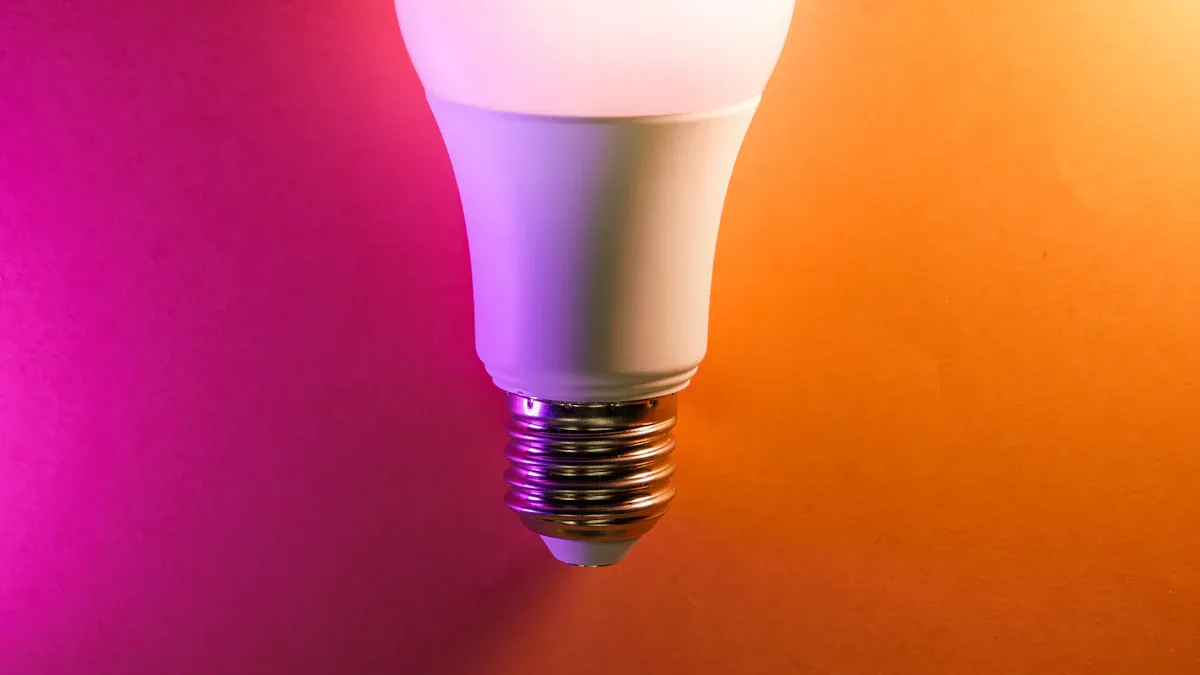
When you choose LED light for your sign, brightness, color temperature, and energy efficiency are crucial factors to consider. These three elements help people see your sign more clearly, influence how much you spend, and ensure your sign lasts longer. Check out the table below to understand how each factor impacts your results. By paying attention to these key points when you choose LED light, your sign will be highly visible, cost-effective, and durable over time.
Factor | Visibility | Cost | Long-term Performance |
|---|---|---|---|
Brightness | Makes your sign easy to see in any weather | You do not need extra lights | Keeps colors bright and clear for a long time |
Energy Efficiency | Lets your sign stay on longer without losing quality | Uses less power, so you save money | Makes less heat, so your sign lasts longer and needs less fixing |
Color Temperature | Helps your brand stand out and makes words easy to read | — | Keeps colors looking right, so your brand stays strong for years |
Key Takeaways
Pick the right brightness so your sign is easy to see. This is important in all lighting, even outside in sunlight.
Choose a color temperature that fits your brand and place. Warm light feels cozy. Cool light looks modern. Neutral light shows real colors.
Use energy-efficient LED lights to save on power bills. These lights help your sign last longer and need less fixing.
Find LEDs with an ENERGY STAR label. These use less energy, stay cooler, and last longer.
Test your sign before you put it up. If your sign is outside, think about weatherproofing. This keeps your sign bright and strong.
Choose LED Light: Key Factors
When you choose LED light for your signage, you want to focus on three main things: brightness, color temperature, and energy efficiency. These are the building blocks for great LED signage. Each one plays a special role in how your sign looks, how much it costs to run, and how long it lasts.
Here’s a quick look at what each factor means and why it matters:
Concept | Definition | Role in LED Signage Lighting |
|---|---|---|
Brightness | Measured in lumens, it is the total visible light emitted by the source. | Ensures visibility and suitability for different applications by controlling how bright the signage appears. |
Color Temperature | Measured in Kelvin (K), indicates the warmth or coolness of the light (2700K warm to 5000K+ cool). | Sets the visual tone or mood of the signage, influencing ambiance and viewer perception. |
Energy Efficiency | LEDs convert most energy into light rather than heat, making them highly efficient. | Reduces operating costs and extends lifespan, making LED signage cost-effective and environmentally friendly. |
Brightness
Brightness tells you how much light your sign gives off. You measure it in lumens. A brighter sign stands out, even from far away or in bad weather. If you want people to notice your sign, you need the right level of brightness. Too little, and your sign disappears. Too much, and it can be hard to read. LED signage gives you strong, even light, so your message stays clear and easy to see.
Color Temperature
Color temperature changes how your sign looks and feels. You measure it in Kelvin. Lower numbers (like 2700K) give a warm, yellowish light. Higher numbers (like 5000K) look cool and white. The right color temperature helps your sign match your brand and stand out in its environment. You can pick a color that fits your business, whether you want a cozy look or a sharp, modern style.
Energy Efficiency
Energy efficiency means your sign uses less power but still shines bright. LEDs are about 75% more efficient than old-style bulbs. They turn most of their energy into light, not heat. This saves you money on electricity and keeps your sign running longer. Efficient LEDs also make less heat, which protects your sign and cuts down on repairs. When you choose LED light, you get a sign that is good for your wallet and the planet.
Tip: Focusing on these three factors helps your sign stay bright, look great, and last for years with less hassle.
Brightness

Lumens
When you look at LED signs, you might notice the word "lumens." Lumens tell you how much light your sign gives off in all directions. Think of lumens as the total "brightness power" of your sign. The higher the lumens, the brighter your sign will look. But brightness is not just about numbers. How you see the light also depends on how the sign spreads it and where you place it.
Lumens help you compare different LED lights. If you want your sign to stand out, you need enough lumens to make it visible. But you also need to think about how the light points at your sign and how far away people will be when they see it. Sometimes, a sign with fewer lumens can look brighter if it focuses the light in the right direction.
Application Needs
Not every sign needs the same amount of brightness. Where you put your sign changes how bright it should be. Indoor signs do not need as much brightness because rooms are usually dimmer. Most indoor LED signs work well with 300 to 500 nits. You can even dim them if the room gets darker, so they do not hurt your eyes.
Outdoor signs face a bigger challenge. Sunlight can be very strong, so outdoor LED signs need to be much brighter. Some outdoor signs need up to 10,000 nits to stay visible in direct sunlight. Even in shaded areas, outdoor signs should have at least 1,500 to 2,000 nits. If your sign sits outside, you want to make sure it can handle bright days and still look clear.
Here’s a quick look at how much brightness you need in different places:
Environment Type | Approximate Ambient Light (lux) | Recommended Brightness (nits) | Notes on Legibility Impact |
|---|---|---|---|
Indoor (standard lighting) | 300–500 | 300–500 | Good for close viewing in low light |
Outdoor (shaded areas) | 1,000–5,000 | 1,500–2,000 | Needed for medium distances |
Outdoor (indirect daylight) | 10,000–25,000 | 2,000–2,500 | Keeps sign clear at longer distances |
Outdoor (direct sunlight) | Up to 100,000 | 2,500+ (max ~3,000) | Best for far viewing and bright sun |
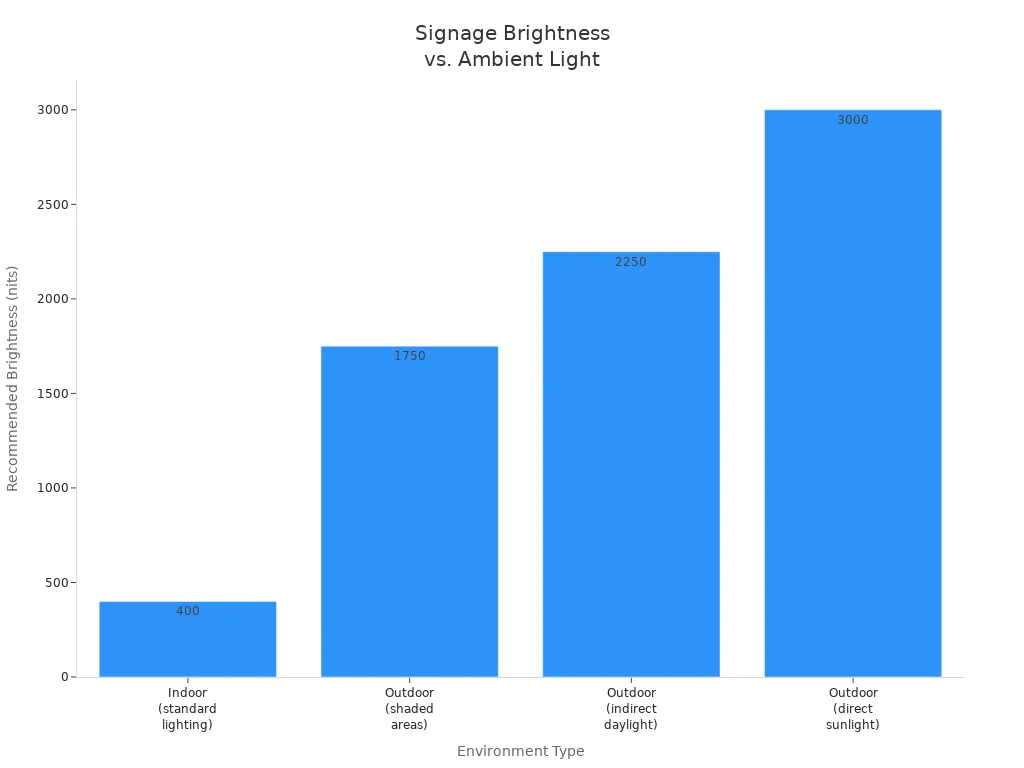
Tip: If you want to estimate the right brightness, try this formula: Ideal Screen Brightness (nits) = Ambient Light (lux) ÷ 2.
Visibility
You want your sign to be easy to read, even from far away. Brightness helps, but you also need to think about glare and over-illumination. If your sign is too bright, it can hurt people’s eyes or make the message hard to read. Glare can even be dangerous for drivers or people walking by. To avoid this, use the right amount of brightness for your space. You can also use special covers or diffusers to soften the light.
Here are some ways to keep your sign clear and comfortable to look at:
Use matte finishes or anti-glare covers to cut down on reflections.
Adjust the brightness based on the time of day or weather.
Pick simple, bold letters that are easy to see from a distance.
Work with a lighting expert if you want the best results.
Micro-LED technology can help your sign look even better. Micro-LEDs use tiny lights that shine on their own. Each pixel can control its own brightness and color. This means your sign can get very bright, show true blacks, and display colors that really pop. Micro-LEDs also last longer and use less energy. If you want a sign that stands out and stays sharp, micro-LEDs are a great choice.
Note: Too much brightness can waste energy and cause light pollution. Always match your sign’s brightness to its environment for the best results.
Color Temperature
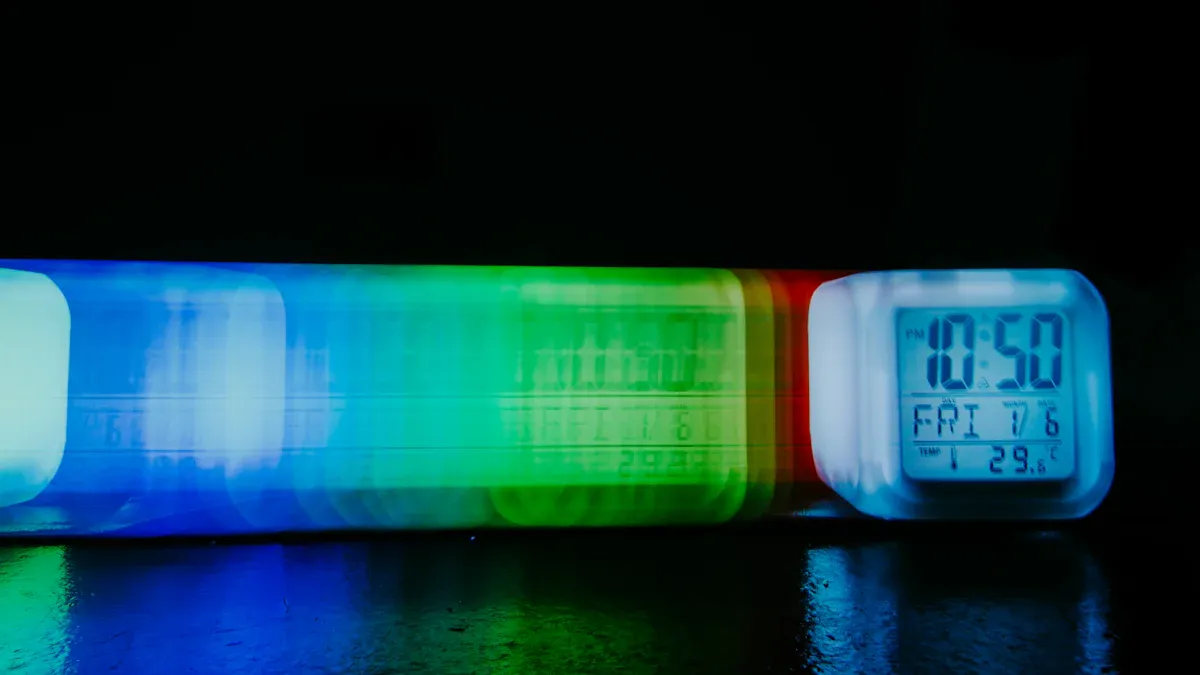
Kelvin Scale
Color temperature tells you how warm or cool your sign’s light looks. You measure it in Kelvin (K). Lower numbers mean warmer, yellowish light. Higher numbers mean cooler, bluish light. Here’s a quick guide to help you see the difference:
Color Temperature (Kelvin) | Light Appearance | Best For |
|---|---|---|
1800K – 3000K | Warm, yellowish | Hospitality, cozy spaces, outdoor patios |
3500K – 4000K | Neutral white | Retail, galleries, balanced environments |
5000K – 7000K | Cool, bluish-white | Outdoor, security, commercial, modern look |
You can use this table to match the right color temperature to your sign’s location and purpose.
Appearance
Color temperature changes how your sign looks and feels. Warm light (2000K–3000K) makes reds and yellows pop, giving your sign a cozy, welcoming vibe. Cool light (4600K–6500K) brings out blues and greens, making your sign look crisp and modern. Neutral light (3100K–4500K) keeps colors balanced, which is great if you want your sign to look natural and clear.
Warm light works well for restaurants, hotels, and gardens.
Cool light is best for stores, offices, and outdoor signs that need to stand out.
Neutral light fits places like retail shops or galleries where you want true color.
If you want your sign to stay readable, make sure the text and background have high contrast. Try testing your sign under different lighting to see how it looks at night or in bright sunlight.
Tip: Cooler whites (4000K–5000K+) usually give you the best visibility for most signage, especially outdoors.
Brand Impact
The color temperature you pick shapes how people feel about your brand. Warm light makes your business seem friendly and inviting. People may want to stay longer in these spaces. Cool light feels sharp and professional. It helps your sign grab attention and makes your brand look modern and efficient. If you want customers to feel relaxed, go with warmer tones. If you want to show energy and focus, choose cooler tones. The right color temperature can help your sign match your brand’s personality and boost customer engagement.
Energy Efficiency
Wattage
Wattage shows how much power your LED sign uses. If the wattage is lower, your sign uses less electricity. This helps you save money every month. LED signs use much less energy than neon or fluorescent signs. For example, neon lights can use up to 400 watts. LED neon signs often use less than 65 watts for the same look. That is a big difference! Most LED signs use about 10 to 30 watts each hour. This is 70-90% less than neon signs. You get bright signs without paying high power bills.
The kind of LED technology changes how much power you use. MicroLEDs and MiniLEDs use even less energy than older LEDs. Outdoor signs that are very bright need more power. But you can choose energy-saving models to spend less. Here is a table that shows how different LED types compare:
LED Technology | Power Consumption (W/m²) | Brightness (nits) | Typical Use Case |
|---|---|---|---|
DIP | 600–1000 | 7000+ | Outdoor, high brightness |
SMD | 300–700 | Up to 3500 | Indoor events |
MiniLED | 200–400 | 4000–6000 | Mid-range brightness |
MicroLED | 150–300 | 5000+ | Premium, ultra-efficient |
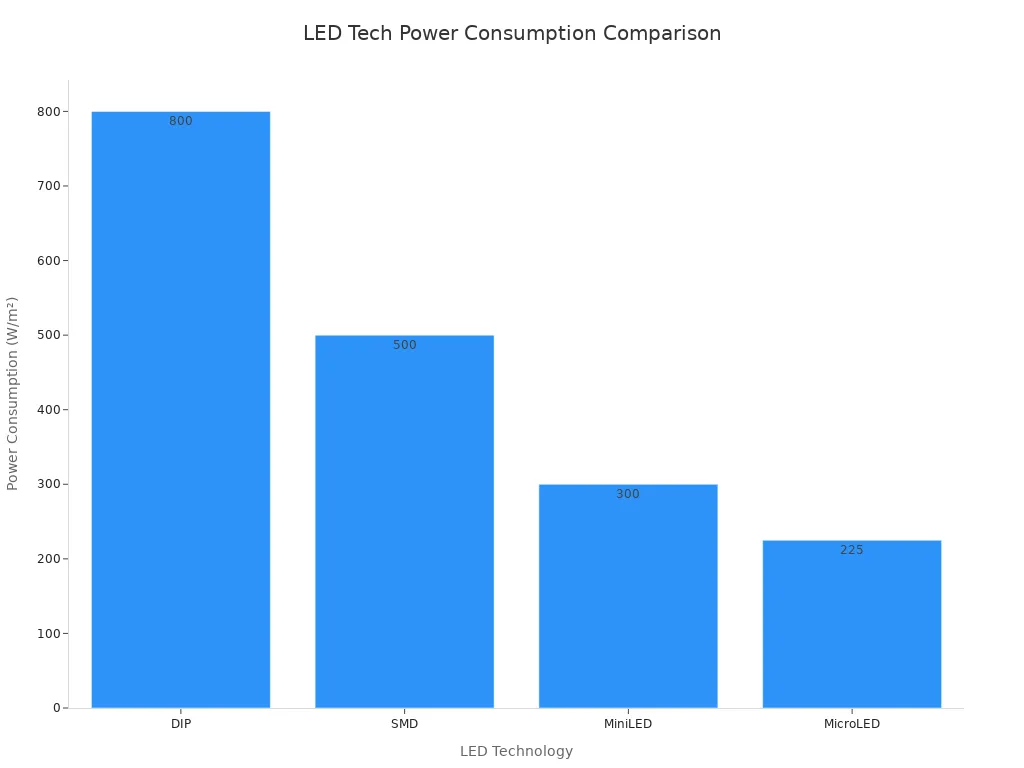
Certifications
You should check for ENERGY STAR certification on your LED sign. This label means your sign saves energy and works well. ENERGY STAR products use 40-60% less energy than regular signs. They also stay cooler, last longer, and cost less to fix. Here is why ENERGY STAR matters:
ENERGY STAR is supported by the U.S. EPA and Department of Energy.
Certified signs are tested by outside groups for power use.
You are protected from false energy saving claims.
Certified signs can work with building automation to save more.
Both home and business signs can get this label.
Tip: ENERGY STAR certified LED signs help you save money and protect the planet.
Longevity
LED signs last much longer than other lights. Many LED signs work for 25,000 to 100,000 hours. That means years of bright light! You do not need to change bulbs or fix your sign often. This saves you money and time. LEDs are strong and do not break like glass tubes in neon or fluorescent signs. ENERGY STAR LEDs also control heat better, so they last even longer.
Lighting Technology | Lifespan (hours) | Maintenance Cost Implication |
|---|---|---|
LED Lighting | 25,000 - 50,000+ | Low due to long lifespan and fewer replacements needed |
Incandescent | ~1,000 | High due to frequent replacements |
Fluorescent | 8,000 - 10,000 | Moderate, requires periodic bulb changes and maintenance |
Halogen | 2,000 - 4,000 | Higher maintenance due to shorter lifespan |
HID | 10,000 - 20,000 | Moderate maintenance costs |
Note: Red LEDs use even less energy, and micro-LEDs make signs last even longer.
Practical Guide
Selection Checklist
Ready to choose LED light for your sign? Use this step-by-step checklist to make the process simple:
Check brightness first. Make sure your sign will stand out in any lighting.
Pick energy-efficient LEDs. This keeps your power bills low and your sign shining longer.
Match color temperature to your brand. Warm or cool, the right color sets the mood.
Look for color consistency. Your sign should look even and professional.
Decide on voltage. Most signs use 12V or 24V, so match it to your setup.
Compare lumens. Higher lumens mean more brightness, but don’t waste energy.
Check for certifications like ENERGY STAR. These signs save energy and last longer.
Key Step | Why It Matters |
|---|---|
Ensures your sign is visible in all conditions | |
Choose energy efficiency | Saves money and reduces maintenance |
Ensure color consistency | Keeps your sign looking sharp and professional |
Determine voltage | Matches your electrical setup for safe installation |
Assess lumens output | Balances brightness and energy use |
Consider color temperature | Sets the right mood and matches your brand |
Tip: Always test your sign before final installation to check for brightness, color, and clarity.
Indoor vs. Outdoor
Indoor and outdoor signs need different LED solutions. Indoors, you can use softer lights and creative materials like acrylic or glass. These signs often use LED strips or backlit panels for a smooth look. You can dim indoor signs to match the room’s mood.
Outdoor signs need to be tough. They face rain, dust, and big temperature swings. Pick weatherproof LEDs and strong materials like aluminum. Outdoor signs need higher brightness to stay visible in sunlight. Anti-glare covers help people read your sign day or night. Some outdoor signs even use solar power or smart sensors to save energy.
Factor | Indoor Signs | Outdoor Signs |
|---|---|---|
Brightness | Moderate, often dimmable | High, with anti-glare features |
Weather Resistance | Not needed | Essential—look for waterproof and durable parts |
Energy Use | Lower, with energy management tools | Higher, but can use solar or smart controls |
Maintenance | Simple cleaning | Regular checks for weather damage |
Note: Outdoor signs must follow local rules for brightness and placement.
Common Mistakes
Many people make the same mistakes when they choose LED light for signage. Here are some to watch out for:
Picking the wrong type of lighting. LEDs work best for most signs.
Ignoring local laws. Some places have rules about sign brightness and color.
Forgetting about energy efficiency. Inefficient lights cost more and waste power.
Skipping weatherproofing for outdoor signs. Rain or dust can ruin your sign.
Not testing the sign before installing. Always check how it looks in real life.
Using the wrong color temperature. The wrong shade can hurt your brand’s image.
Choosing low-quality parts. Cheap LEDs fail faster and cost more over time.
Not planning for maintenance. Regular cleaning and checks keep your sign bright.
Overlooking light pollution. Too much light can bother neighbors or break rules.
LED signs give you lots of design freedom. You can show moving text, change colors, or update messages anytime. This helps your brand stand out and keeps your sign fresh and eye-catching.
When you pick LED light for your sign, you help people see it better. You also spend less money and your sign lasts longer. Choosing the right brightness, color temperature, and energy efficiency saves you money every year. Some places can save more than $100 each year by using LEDs the right way.
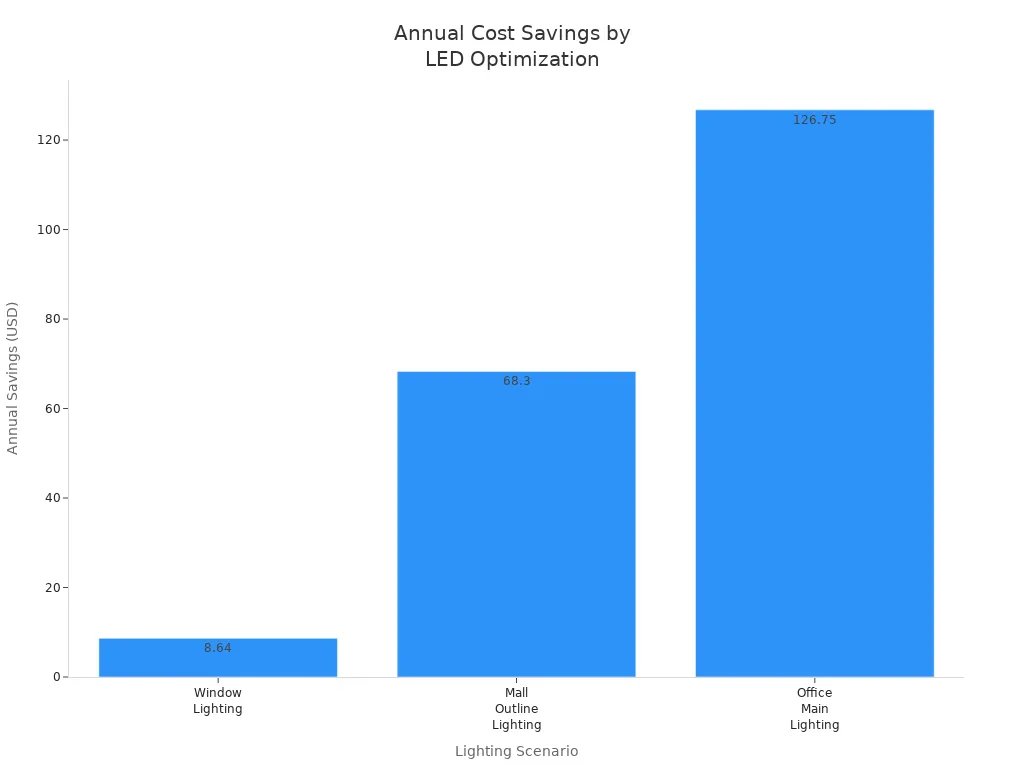
Follow the checklist and tips above to make good choices. Start now—focus on these things and your sign will look better and work well for you.
FAQ
What is the best brightness for outdoor LED signs?
You want your outdoor sign to stand out, even on sunny days. Look for LEDs with at least 2,000 nits. If your sign faces direct sunlight, go higher. Test your sign outside before you install it.
How do I pick the right color temperature for my sign?
Think about your brand and where you place your sign. Cool white (4000K–5000K) works well for most signs. Warm white (2700K–3000K) gives a cozy feel. Try different options to see what fits your style.
Do LED signs save money on energy bills?
Yes! LED signs use much less power than old lights. You can save up to 70% on your energy bills. LEDs also last longer, so you spend less on repairs and replacements.
Can I use the same LED lights for indoor and outdoor signs?
Not always. Outdoor LEDs need to handle rain, sun, and dust. Look for waterproof and weatherproof ratings. Indoor LEDs do not need these features. Always check the label before you buy.
How long do LED signs usually last?
Most LED signs last between 25,000 and 100,000 hours. That means your sign can shine for years without needing new bulbs. You get bright light and less hassle.
See Also
Selecting The Best LED Display Sign For Your Company
Finding The Ideal LED Digital Sign To Meet Business Needs
Exploring LED Sign Types, Tech, And Deployment Methods
Comprehensive Guide To LED Sign Boxes: Specs, Setup, ROI
Boosting Exposure Using Rotating LED Signs: Advantages And ROI

